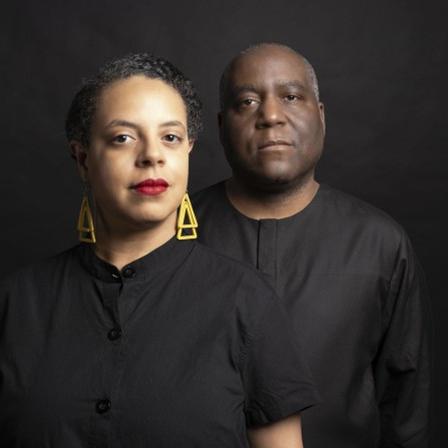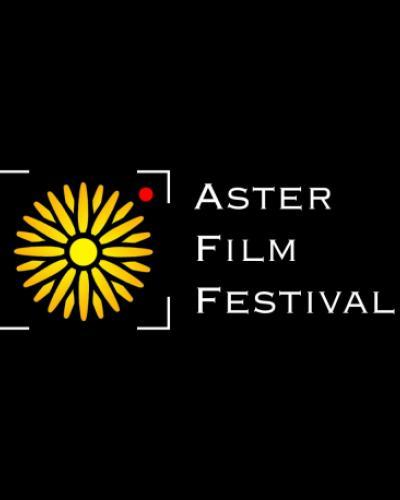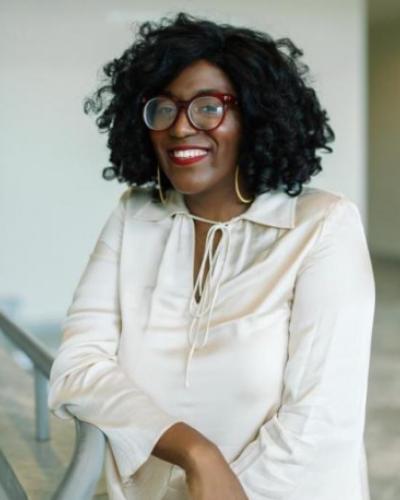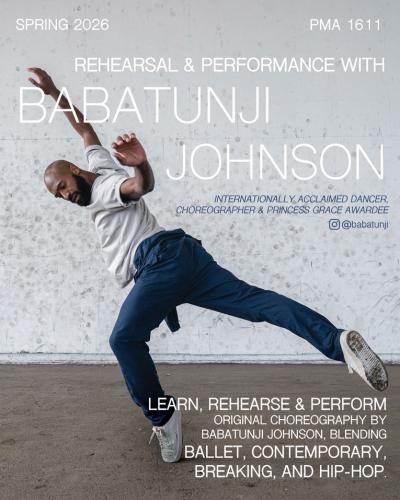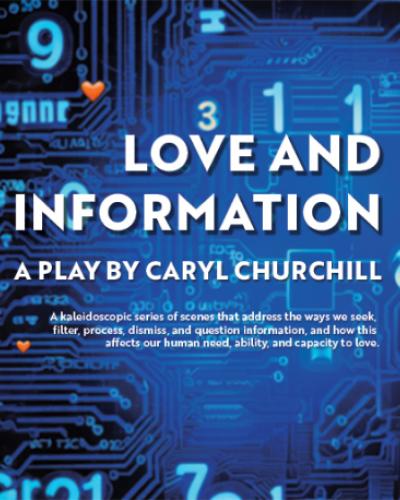In this episode, Leah Ingalls, a junior in PMA major, and Chris Christensen, IT Support, meet with PMA Senior Lecturer Carolyn Goelzer to discuss the upcoming production of LOVE AND INFORMATION. Click HERE to learn more about LOVE AND INFORMATION.
Click HERE to see more episodes.
Transcript
Chris Christensen 0:11
Hello and welcome to episode 49 of the PMA Podcast. In this episode, Leah and Chris met with senior lecturer, Carolyn Goelzer, to discuss the upcoming production of Love and Information by Caryl Churchill, as performed by the students of PMA 3801. Carolyn, welcome back to the PMA Podcast.
Carolyn Goelzer 0:31
Yes, thank you, Chris. It's nice to be here.
Chris Christensen 0:33
Yeah, so, what were we talking about the last time you were here? It has been some time.
Carolyn Goelzer 0:40
It has been, and I'm trying to remember what that would have been. Maybe it was Tar Tooth? I don't know. It could have been.
Chris Christensen 0:47
For some reason that rings a bell, I can kind of see the image of the, the poster in my mind. Yeah. So today, we're talking about Love and Information.
Carolyn Goelzer 0:59
Yes.
Chris Christensen 0:58
And it's coming up rather quickly.
Carolyn Goelzer 1:00
Yes, thank you for that reminder.
Chris Christensen 1:04
Sorry, I just... (laughter)
Carolyn Goelzer 1:08
Yes, it's a big play to prepare. So this play by love, Love and Information by Caryl Churchill, one of the most recent plays that she's written was written in 2012. It was first introduced at the Royal Court Theatre in England, in London. And it was directed by James McDonald, who was a longtime collaborator of hers. And the play is really unusual, because it's got a very open structural frame. And that was created by the playwright for the interpretive artists to explore in their own way. So essentially, it's a collection of scenes that have no given circumstances attached to them. There is a bank of language that's provided by Churchill, for each of the scenes. Some of the scenes are very short, maybe less than a minute long. And some of them are several minutes long. But there is no allocation of which character speaks what line. So that's something that can be assigned by the creative team as we're working on it. And the actors have the ability to be able to bring in their interpretation of what they think that language, the story that they think that language might serve. So it's a wonderful opportunity for us to combine using our interpretive skills in response to language provided and a structural framework, but then also gives us the opportunity to invent what the play is about.
Chris Christensen 2:41
Okay.
Carolyn Goelzer 2:43
So that's been our, our work for the last few weeks, and that we continue to strive to understand more about as we come to the time when we're going to publicly present this work.
Leah Ingalls 2:56
Right. And this is being put on as part of a course, correct?
Carolyn Goelzer 3:00
Correct.
Leah Ingalls 3:01
And so I was just wondering if you could share a bit about how in the course you have collaborated with the students to sort of formulate those characters in those scenes.
Carolyn Goelzer 3:10
Yes. So we worked with a model that they used originally at the Royal Court Theatre, which was to give a chunk of text to a team of actors and say, come up with two versions of this scene that you can imagine and be as bold and as generous in the ways that you can think about the theatricality of this scene. Don't feel restricted by working with naturalism. Some of the scenes might be tropes or ideas, archetypes of, of takes of materials that we encounter in our everyday lives, that have their own theatricality. And some of them may be just very close to the bone confessional scenes between characters that share an intimate relationship of some kind. So the actors were tasked with that. They get they meet outside of class, they come in with two versions of the scene. We look at them, we laugh a lot in class. And then we select one of the two to explore further. So most of our work is kind of looking at the different potentials, theatrical potentials of the scenes and then gravitating toward a choice, putting that in a collection of scene work that we will then sequence later. Because the other thing that Caryl Churchill does is she has these scenes arranged in seven sections. She tasks us to sequence those scenes in whatever way we wish. So as we're working from section to section, we're also thinking about what are the other scenes in that section? Is there a particular area of content that's being explored? How can we use that information to provide a really exciting sequence? How does it hand off from the last sequence? How does it contribute to our understanding of the next sequence? So not only are we imagining what the scenes are about, we're also trying to figure out how they, what order gives the most dramatic interest to the collection in the end. There's also, just to complicate things further, there's also a collection of scenes that Churchill provides at the end of the play that she calls random scenes that can be realized and added at any place…
Leah Ingalls 5:46
Really?
Carolyn Goelzer 5:47
…Within the play structure. So the actors and I have worked to find ways to interpret the scenes, but then we sat down one day in class, and we actually had Post-It notes, and we stuck them all up on the board. And we sequenced the play. And now we're working through the play in that sequence that we've outlined for ourselves. I'm sure there'll be some changes as we move forward. That's, that's the hardest part is that it requires a lot of flexibility on everyone's part, because there's a lot of changes that happen pretty much day to day, as we understand more about how this play fits together in its components.
Leah Ingalls 6:29
That's incredible. That sounds like a really beautiful synthesis between actor and writer in a sense, and, and director and writer.
Carolyn Goelzer 6:36
Yes, it puts more power, creative power into the hands of the actors, which is something that I've always promoted. As an acting teacher, I always feel that actors don't have enough creative agency. As interpreters, they're under-utilized as sources for creative input as to what a piece is, and this project puts the actor squarely in the position of being able to contribute in a creative artistic sense, as well as in their performing choices.
Chris Christensen 7:09
So why Love and Information? What, what inspired this for you, Carol?
Carolyn Goelzer 7:13
It's a very contemporary theme for me to take these two areas of modern life, the way we love and the way that we receive information and look at how information really impacts the way that we think about love, the way that we negotiate our love relationships, how when we receive certain kinds of information, we take turns and have to reevaluate and have to explore things differently than when we're without it. So how does it, how does actual information, sometimes it's technical information, information that comes to us through technology, which of course, is a very modern conundrum. We have one character in our play, that's actually a robot.
Leah Ingalls 7:57
Oh, wow.
Carolyn Goelzer 7:58
Is an AI, construction. And so you were able to see, you know, is this being sentient? Is this being, you know, how is this being helping us to understand what it means to love? Does it have the capacity to love? So sometimes we're looking at the interface of technology and love in, in that particular way, sometimes we're looking at information as being memory, or being some kind of brain function that is unusual or goes awry. And then how does that change in the way that we actually, our minds actually work? How does that change affect the way that we proceed? So it's quite big, I think there's quite a, there's a largess in the way that Churchill is encouraging us to think about that inter, intersection between love and information. But that's our, that's our work.
Chris Christensen 8:58
Okay.
Leah Ingalls 8:59
That sounds very philosophically provoking.
Carolyn Goelzer 9:03
It is but you know, what's really fun about the pieces, the characters, because there's, you know, there's 40 plus scenes, and we have an ensemble of five actors, five really incredible actors. So they are transforming from scene to scene, they're creating different personi that are unpacking these situations. And so the fun part is just watching these actors take on different personi to tell different stories about that interface of love and information. So it's, it's very entertaining by its by its nature, because of all of those quick transitions and transformations that happen from scene to scene to scene and gives the actors a lot to do.
Leah Ingalls 9:49
Absolutely. I was actually very curious about how, one, how many characters there are and also, how you've worked with the students and how they've worked with each other to sort of navigate those rapid transitions from character to character. And from scene to scene.
Carolyn Goelzer 10:04
Well, I mean, we've, right, at this point in our process, we have identified the different personi that we want to create in our scenes. But we haven't done a lot of transisting yet in real time, from character to character to character. So we'll see how that goes. We know how we're going to negotiate the space, that's something that, you know, becomes part of those transitions. Where does one scene take place? How do we put the next scene in, in another container, spatial container that gives it some particular support for the content of the scene. So we kind of know traffic patterns at this point how that all works out. But we don't know how, how hard it's going to be to actually go from robot to lover to weather reporter or whatever that might be. However, the performers are quite nimble. And I suspect that they'll, they'll find ways of finding those triggers, whether they're physical triggers, or whether they’re vocal triggers that will help them just take that leap into that next character that needs to happen. And they're not all in every scene. So they have a little bit of a rest, usually in the sequencing of their own tracks, that allows them to gather themselves, to ready for the next performing opportunity that they are, that they're, that they're engaged in. So that's the way we're, we're working now.
Chris Christensen 11:36
I'm curious, thinking about how students in this play really have grown up with technology as a part of their lives. Like is it, there's no separation for 20 years ago, or so, there wasn't social media, you and I didn't have social media growing up. And I wonder how their experience informs these characters, are there types of discussions that are taking place about their experiences with social media technology, that sort of thing?
Carolyn Goelzer 12:00
Yes, there and the, the actors very readily bring in technology as just a normal way of, of having discourse with one another, you know, whether it's pulling out their phones, we have one particularly fun scene where, you know, someone's being fired, and they get kicked out of the office, and they start to text, you know. So it's these kinds of segues into using technology as a means of communication or something very organic to these actors. And yes, they were not part of my generation, I actually didn't have email growing up. So you know, that's, that's how that's how old I am.
Chris Christensen 12:43
Yeah, I think I got my first email account. I was in my early 20s. Yeah, I think I had a Hotmail account. That's where I started. Yeah.
Carolyn Goelzer 12:53
And they're using, you know, their cell phones for photography, we have projection capability during the show, and we also have live feed from an offsite booth, if you like, that provides information on a screen that is shared with the audience. So we're also trying to integrate some technology in the way that we're telling the story as well, not just from the, the character standpoint, but then actually from the, the aesthetics of the show itself. And our set designer, Jason Simms has built us a set that allows projective capability in a myriad of ways. So we're, you know, we're experimenting with that. Right, right now, we have conceptualized that part of the play, but we haven't actually been able to use it yet, in rehearsal. That's something that will happen later, when we get into more of a tech environment. But it's exciting to think about how image can supplement, support content that's going on, on stage. And a lot of that is in juxtaposition, sometimes it's providing a whole different set of information that is in in combination with what we see on stage. Sometimes it's actually giving literal support to things that are said. So, you know, maybe it's a PowerPoint presentation by someone who is trying to sell a product. You know, we're also interested in entertainment tropes. So, whether it's a game show or a film noir or a soap opera, so we're looking at ways that information is communicated through technology as entertainment in our everyday lives, and how that is received and how that helps to shape our ideas about what love can mean. So you can see, it's quite capacious the realm that we are of information that we're trying to negotiate. But somehow because of Churchill's writing, it all feels like it's of a piece.
Leah Ingalls 15:15
That's very interesting. It's almost like it bridges the gap, per se, between the performing and the media that we have here at PMA?
Carolyn Goelzer 15:23
Yes, I think one hope is to really look at the interdisciplinary nature of performing and media and how we can continue to find unusual and interesting ways to combine those two things: live theatre, and mediated performance or mediated information. And it's actually a very exciting terrain. I think that PMA is more and more interested in those intersections. And it's fun to experiment with this piece, which seems to really give us a very particular set of opportunities to exploit it.
Leah Ingalls 16:00
Absolutely. I was wondering, you touched a bit on the set design, you can share as much or as little information on this as you wish. But is there anything you'd like to share about the set design, the costume elements going into this.
Carolyn Goelzer 16:17
We're very fortunate that we have a production team for this play. For it, it's, as a course, you know, to be able to have the support of a full production team is really pretty fantastic. And our designers never disappoint, they come up with fantastic ideas. Our set by Jason Simms is really a large shell that occupies most of the Flex Theater. So it's quite large, it is white and black on a grid. So some of the areas of the set are specifically designed to receive images. And we also have exits and exits that are on all three of the walls that are part of this shell. So we're able to use that flexibility in ways to create narrative with light, with projection, and with areas of the space being dedicated to certain activities that get, then get repeated throughout the play. We, the black and white sort of stark nature of it is obviously helping to support this technological part of our, of our world, of the realm of, of our world. And then we have in, in contrast and in counterpoint to that, we have very naturalistic scenic elements that are more in earthtones, that provide color that have more of an organic feeling to the human emotional part of our play. So those two, two aesthetic elements are working in combination to build and tell story. And then the costume pieces are, they have to be, they, they, the, Sarah has done this fantastic job of being able to just find a couple of things that will situate the onstage situation in specific ways without requiring a large costume change. Because we don't have time for that we're, we're moving so fast, from scene to scene to scene, it's grab a hat, grab a, you know, change your shoes, put a coat on, I mean, it's, it's very fast in terms of the transitions that have to happen costume wise. So she's, she's thinking, I think, more in terms of accentuating elements that will give specific place to the characters that are, that are working in this story.
Chris Christensen 19:01
Thank you. I really appreciate all the description there. I can really envision it in my mind. I know in the past, we sometimes take our performance spaces and split up the seating to accommodate the set. Is this just the standard seating as it is now? Or is there anything going to change in that regard?
Carolyn Goelzer 19:16
No, it's it's a, it's a pretty standard proscenium situation there in the Flex. The shell takes up the width of the playing area and the depth of it for the most part. So the audience will be looking at the information from straight on. And also because we're using projections, it makes sense to have the audience oriented in a place where they're all able to see those projections clearly and that's in front.
Chris Christensen 19:47
Okay.
Leah Ingalls 19:48
Does audio play a part in the, in the production? I know you mentioned projection.
Carolyn Goelzer 19:53
There is a soundscape, so we have some particular ideas for music that we want to underscore certain scenes, we have sound effects in some of our scenes. So, yes, that, those elements are also going to be added. Some of them are part of little films that are projected and built in to those. And then others will be created by Warren Cross. So he'll be providing some support for ambient sound and specific accents of sound that are needed.
Chris Christensen 20:28
Do you know if the crosswind is going to be involved in these sounds?
Carolyn Goelzer 20:32
I don’t know!
Chris Christensen 20:33
Do you know about this instrument of his?
Carolyn Goelzer 20:33
I do know about it, yeah, it's quite an exciting instrument to think about maybe integrating. I don't know how it will be up to him.
Chris Christensen 20:43
Okay.
Carolyn Goelzer 20:44
We let everybody do exactly what they want to do, until we're really in trouble. (laughter) Kind of the way we go. And, you know, I don't know how to open up the creative possibilities in any other way that really invites true collaboration to happen. So, you know, it's open arms for, for everything until it just can't work anymore.
Chris Christensen 21:08
Okay.
Carolyn Goelzer 21:09
Yeah. So we're definitely in a gathering space, it's stage of our work together. And then it's going to be brutal, we're going to have to just make some hard choices. But hopefully, we'll understand, you know, from the explorations that we've done in all of these different areas, what needs to happen, you know, to actually make it make a certain coherency. And, and be fun to watch.
Chris Christensen 21:35
Okay.
Leah Ingalls 21:36
That’s beautiful, I think in a way it adds to sort of the theme of, of technology, and that, as individuals, we have gained more ability to act freely and act as individuals having this technology and this information in our hands. And in that way, each individual person in the production gets to have such a big, a big role.
Carolyn Goelzer 21:56
Yes, exactly. It's really fun too, as an actor, right, I remember these feelings a lot, where I worked in an experimental theater for nine years, and we did everything. You know, it's kind of, we were painting the furniture, while the audience was waiting to buy their tickets. (laughter) I mean, you know, it was always, there was always something a little like, ahhh, about it. But it's wonderful to be able to actually contribute to a creative process, I think that our buy in is really different when we work on a piece like that. And it's, it's my love of that kind of collaborative spirit that has really motivated me to explore this material with the students.
Leah Ingalls 22:36
Absolutely.
Carolyn Goelzer 22:37
Their ideas are fantastic, you know. It takes the director out of an auteur relationship to the material and puts the director more into how to conceptually organize what is created. And that's a role that I feel very comfortable in. And I really enjoy that.
Chris Christensen 23:02
One of the questions I love asking, because I'm always interested in how it's going to go is what do you hope the audience will take away from the performance?
Carolyn Goelzer 23:11
I think that I'm, I'm hoping that the audience will really reflect on their own personal relationships to how information impacts their, their love, for each other, and for themselves, you know. And I, I, I just really hope that there's an opportunity for us all to reflect on how technology changes that, or impacts it. And then also, to really understand that different people are impacted in different kinds of ways. And to be able to see that in play, even in imaginative circumstances that are created in our production, you know, that there… We can't, we can't really ever second guess other people's experiences with these things. And maybe it just opens our eyes to different ways people are affected by information and how that gives them steerage in their own life choices and their own life experiences. So, you know, it, it's a rumination about that for me, and I'm hoping, I'm hoping that the audience will be entertained. There's a lot of very dark material in the play, but there's also a lot of humor, and I'm hoping that, you know, we get that, that chemistry right so that as the audience is confronted with these ideas, that they're, they, they have, there's an ability to be able to sit back and laugh a little bit at it, you know, as well as take in the, the, the bigger manifestations of how these things actually create struggle for us as well.
Leah Ingalls 25:06
Is there is there anything else that you'd like to share about, about the process, about, about the background of this or anything?
Carolyn Goelzer 25:17
Ah. Not, not specifically, I mean, we have really enjoyed being able to use our course, course structure to, to create this piece. And, you know, the hardest thing about it is trying to work within our class time…
Leah Ingalls 25:40
Right.
Carolyn Goelzer 25:41
That we have available for each other, which is only four hours a week. So, you know, when you think about preparing a full length play, we invest many more hours than that, usually, in a rehearsal performance process. So we've been challenged by that, we've been able to cut many of the scenes of the play to get it down to a playable length that we're, you know, we're, we're not swimming and to try to make, meet all of the deadlines and get everything realized to the level of expertise that we want to before sharing for an audience. But that's been our, our biggest challenge really, is trying to figure out how to most effectively use our time to make this piece happen. And yet, it makes so much sense to me that we're doing it within a course structure where students can come in and know that they're earning credit to do the work that they're doing. And that they don't have to commit huge numbers of hours for the weeks before an opening night to, outside of, you know, outside of their dedicated class time to, to participate. So that's been something that I think has been unique to this project, that we've had to use that time framework to prepare. It's, you know, it presents its challenges. And it also has its very clear rewards.
Chris Christensen 27:08
Yeah, a different sort of personal commitment to the class itself on the student’s part.
Carolyn Goelzer 27:12
Yeah, I think that's true.
Leah Ingalls 27:14
And opens a sort of space for discussion.
Chris Christensen 27:20
Carolyn, thank you so much for being on the podcast again.
Carolyn Goelzer 27:24
Well thank you for inviting me, I hope you'll have a chance to come to see the show. We've been working hard on it, and we really are looking forward to having the audiences come and share their experiences with us.
Chris Christensen 27:38
Okay. Thanks so much.
Carolyn Goelzer 27:40
Thank you.
Chris Christensen 27:42
Thanks for listening to the PMA Podcast. Performances of Love and Information will take place on Friday, November 17th, and Saturday, November 18th at 7:30pm in the Flexible Theatre of the Schwartz Center for the Performing Arts. Tickets are free and available to the public at pma.cornell.edu. Love and Information is presented by arrangement with Concord Theatricals on behalf of Samuel French Incorporated, www.concordtheatricals.com.

